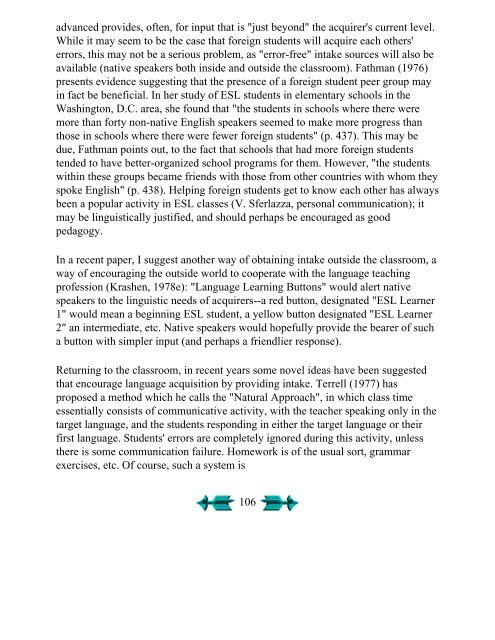Second Language Acquisition and Second ... - Stephen Krashen
Second Language Acquisition and Second ... - Stephen Krashen
Second Language Acquisition and Second ... - Stephen Krashen
You also want an ePaper? Increase the reach of your titles
YUMPU automatically turns print PDFs into web optimized ePapers that Google loves.
advanced provides, often, for input that is "just beyond" the acquirer's current level.<br />
While it may seem to be the case that foreign students will acquire each others'<br />
errors, this may not be a serious problem, as "error-free" intake sources will also be<br />
available (native speakers both inside <strong>and</strong> outside the classroom). Fathman (1976)<br />
presents evidence suggesting that the presence of a foreign student peer group may<br />
in fact be beneficial. In her study of ESL students in elementary schools in the<br />
Washington, D.C. area, she found that "the students in schools where there were<br />
more than forty non-native English speakers seemed to make more progress than<br />
those in schools where there were fewer foreign students" (p. 437). This may be<br />
due, Fathman points out, to the fact that schools that had more foreign students<br />
tended to have better-organized school programs for them. However, "the students<br />
within these groups became friends with those from other countries with whom they<br />
spoke English" (p. 438). Helping foreign students get to know each other has always<br />
been a popular activity in ESL classes (V. Sferlazza, personal communication); it<br />
may be linguistically justified, <strong>and</strong> should perhaps be encouraged as good<br />
pedagogy.<br />
In a recent paper, I suggest another way of obtaining intake outside the classroom, a<br />
way of encouraging the outside world to cooperate with the language teaching<br />
profession (<strong>Krashen</strong>, 1978e): "<strong>Language</strong> Learning Buttons" would alert native<br />
speakers to the linguistic needs of acquirers--a red button, designated "ESL Learner<br />
1" would mean a beginning ESL student, a yellow button designated "ESL Learner<br />
2" an intermediate, etc. Native speakers would hopefully provide the bearer of such<br />
a button with simpler input (<strong>and</strong> perhaps a friendlier response).<br />
Returning to the classroom, in recent years some novel ideas have been suggested<br />
that encourage language acquisition by providing intake. Terrell (1977) has<br />
proposed a method which he calls the "Natural Approach", in which class time<br />
essentially consists of communicative activity, with the teacher speaking only in the<br />
target language, <strong>and</strong> the students responding in either the target language or their<br />
first language. Students' errors are completely ignored during this activity, unless<br />
there is some communication failure. Homework is of the usual sort, grammar<br />
exercises, etc. Of course, such a system is<br />
106











